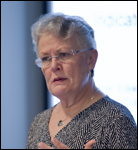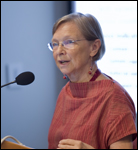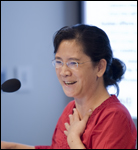Showing posts from category education.
-
Hans Rosling Double Feature: ‘The Joy of Stats’ on BBC and Population Growth at TED
›Hans Rosling, creator of Gapminder and professor of international health at Sweden’s Karolinska Institute, hosts a new documentary on the BBC called The Joy of Stats that takes a look at the breadth and depth of data available today to analysts and private citizens alike.
In the clip above, Rosling demonstrates his primary interest in world health, tracking life expectancy and income over the last 200 years to show both the remarkable progress that has been made but also the tremendous gap that remains between those at the top (the very rich and healthy) and those at the bottom (the very poor and sick).
Rosling has been a vocal (and visual) advocate for expanding people’s knowledge of the world by presenting statistics in innovative ways. “Statistics should be the intellectual sidewalks of a society, and people should be able to build businesses and operate on the side of them,” he said at a discussion at the Wilson Center in May 2009.
In particular, Rosling’s focus has been on health, poverty, and the developing world, where he’s advocated for increased focus on child and maternal health and education. “The role of the old West in the new world is to become the foundation of the modern world – nothing more, nothing less,” he said during a TED talk on population growth (see below) where he broke from his more flashy visuals and went analog – using IKEA boxes to illustrate population and consumption growth. “But it’s a very important role. Do it well and get used to it.”
Rosling’s Gapminder software has been incorporated into Google’s Public Data Explorer, where many development indicators from the World Bank, World Health Organization, and others can now be easily tracked by anyone. For more on Google Data and to see an example set of indicators (agriculture as a percentage of GDP vs. fertility rates over the last 50 years), check out this previous Eye On, on The New Security Beat.
Video Credit: “Hans Rosling’s 200 Countries, 200 Years, 4 Minutes – The Joy of Stats – BBC Four,” courtesy of BBC, via YouTube, and “Hans Rosling on global population growth,” courtesy of TED. -
Empowering Women in the Muslim World
›December 2, 2010 // By Wilson Center StaffOriginally featured in the Wilson Center’s Centerpoint, November 2010.
For decades, women in the Middle East have actively struggled for equal status before the laws of their respective countries. They have strived to attain equal participation in politics and society, and progressive justice throughout the region. While they have made progress in some parts of the region, many challenges remain. The Wilson Center’s Middle East Program recently held three meetings to discuss challenges as well as progress to empowering women across the Muslim world.
A Modern Narrative
The American Islamic Congress (AIC) recently published a report, “A Modern Narrative for Muslim Women in the Middle East: Forging a New Future,” that highlights past and present triumphs and difficulties – economic, legal, political, religious, and social –for women’s rights throughout the region. On September 30, the Middle East Program co-sponsored a meeting with the AIC to review the status of women in Saudi Arabia and Jordan, based on findings in the AIC’s report.
Fawziah Al-Hani, manager of the Gherass Center for Social Education in Saudi Arabia, expressed frustration about the progress women have made in her native Saudi Arabia. She said women there are perceived as second-class citizens by the country’s legal, economic, political, religious, and social institutions. Women’s issues are rarely discussed in Saudi political and social spheres, and women are not represented in government or the business sector. She said if women are allowed to be active outside the home, they are mostly restricted to educational and health activities.
While she is frustrated about these restrictive Saudi policies toward women, Al-Hani said she maintains hope, as changes take place within the society and government through new initiatives and movements.
Rana Husseini, a human rights activist, author, and journalist, detailed the changes to the status of women in Jordan over the past 20 years. Husseini, whose human rights activities over the past two decades in Jordan have focused on honor crimes and other women’s issues, said Jordan has made substantial progress on women’s rights as a result of intense media and civil society activism. While there is room for improvement, she said women are now participating in government and significant reforms have been made to the judicial system.
Though the effectiveness of quotas for women in government may be debated, Husseini noted that quotas facilitate women’s participation in elections and government service. In fact, she said, there are some 50 women judges in Jordan. She noted that honor killings, except in extreme cases, are becoming rarer, and harsher sentences are being imposed for honor crimes.
With constant pressure on the government and society, reforms will continue, said Husseini, who is optimistic about the future for women rights in Jordan and in the Middle East as a whole.
Demographic Realities
Why do many Middle Eastern women not enjoy the same economic opportunities as women of other regions? Can they be empowered to participate at a greater level? Nadereh Chamlou, a senior adviser at the World Bank, attributed the gender inequality to restrictive social norms. She said the region’s women must be empowered to participate in a more significant way if their countries are to effectively exploit, instead of squander, the current economic “window of opportunity.”
At a September 13 discussion, Chamlou said the good demographic news is that there are high numbers of working-age people and thus the potential for rapid economic growth. However, Middle Eastern countries have the highest dependency rates in the world, a fact that Chamlou attributed to the low economic participation of Middle Eastern women relative to female citizens’ participation in other parts of the world. This reality means the Middle East’s demographic composition will not be exploited to its full potential.
Increasing economic opportunities for women will require changing social norms, said Chamlou. She cited a study conducted by the World Bank in three Middle Eastern capitals – Amman, Jordan; Cairo, Egypt; and Sana’a, Yemen – that revealed the biggest reason for the poor representation of women in the workforce is the negative male attitude regarding women working outside the home. Notably, social norms and such negative male attitudes proved to restrict women’s participation far more than the need to attend to child-rearing duties. Despite the successful efforts of most Middle Eastern states to improve education opportunities, conservative social norms still pose a barrier to female empowerment.
Some simple changes could have a substantial impact. Chamlou recommended focusing on educated, middle-class women, undertaking more efforts to bring married women into the workforce, and emphasizing changing attitudes – particularly among conservative younger men – toward women working outside the home.
Lessons from Tunisia
In Tunisia, the progress of women’s empowerment can serve as a model for the region, noted women’s rights advocate Nabiha Gueddana, president and director-general of the National Agency for Family and Population in Tunisia.
Speaking at a September 8 meeting, Gueddana said the Arab world can learn much from her native Tunisia regarding the positive effects of empowering women. Gueddana, also a candidate for undersecretary-general of UN Women at the United Nations, described how Tunisian women have been empowered politically, economically, and socially, and how this empowerment has benefited Tunisian society.
Tunisia has undergone substantial changes since achieving independence from France in 1956. Tunisian women had second-class status in the years prior, a time Gueddana described as one that relegated them to a life of constant child-rearing, illiteracy, and economic dependence.
Yet Tunisia has become a beacon for other Muslim societies: the country’s labor code allows full female participation in the economy and education is open equally to boys and girls. Family planning programs and important strides in health have considerably lowered the birth rate and lengthened the life expectancy of the average woman. Gueddana also noted that Tunisia’s economic growth is now five times greater than the growth rate of its population.
Measures to empower women in Tunisia have benefited not only women but Tunisian society as a whole, with significant shifts in men’s attitudes regarding women’s rights and roles in society. Gueddana indicated that her efforts extend beyond Tunisia, as she strives to help empower women throughout the world. She said such efforts will persist so long as women anywhere find themselves disadvantaged, dependent, and living as second-class citizens.
Women’s empowerment in society rests increasingly not in the political but in the economic and business domains (Editor’s note: one could add that women’s empowerment has the potential to considerably impact the environmental domain as well). While women have made considerable progress in the political arena, economic power is still male-dominated throughout the region.
Gueddana said the discussion of women’s rights should take place within the broader context of human rights. Violence against women, particularly sexual violence, is a widespread phenomenon across all societies and, unfortunately, often considered taboo for discussion. She said all citizens benefit when all have equal rights and can use them to expand their opportunities and achievements to enhance their societies.
Dana Steinberg is the editor of the Wilson Center’s Centerpoint.
Photo courtesy of Centerpoint. -
Demography and Women’s Empowerment: Urgency for Action?
›Why do Middle Eastern women participate in economic life at a rate lower than that of female citizens of other regions? According to Nadereh Chamlou, a senior advisor at the World Bank, restrictive social norms are to blame. At the Middle East and Environmental Change and Security Programs’ “Demography and Women’s Empowerment: Urgency for Action?” event, Chamlou argued that the region’s women must be empowered to participate in a more significant way if their countries are to effectively exploit, instead of squander, the current economic “window of opportunity.”According to Chamlou, the region is facing a “demographic window of opportunity” where its relatively high numbers of working-age people create the potential for rapid economic growth. However, Middle Eastern countries also have the highest dependency rates in the world. Without opening more economic opportunities for women, the region’s demographic window of opportunity will not be exploited to its full advantage.
Chamlou disputed the commonly held assumptions regarding the historic lack of female participation in the Middle East’s economic sphere, such as the belief that women abstain from joining the workforce because they do not possess the necessary education and skills. She cited statistics showing that the region’s women are represented at a near-equal level as men in secondary school, and to an even greater degree at the university level. They are also studying in marketable fields, disproving the theory that they are not acquiring employable skills.
A survey conducted by the World Bank in three Middle Eastern capital cities — Amman, Jordan; Cairo, Egypt; and Sana’a, Yemen — showed that negative male attitudes regarding women working outside the home were the most significant reason for poor female representation in the workforce. Notably, negative male attitudes restricted women’s participation far more than child-rearing duties. Despite the successful efforts of most Middle Eastern states to improve female education, conservative social norms that pose a barrier to female empowerment remain in place.
Chamlou concluded her remarks with three policy recommendations: 1) Focus on medium-educated, middle-class women; 2) Undertake more efforts to bring married women into the workforce; and 3) Place a greater emphasis on changing attitudes, particularly among conservative younger men, towards women working outside the home. Such changes could more effectively utilize the Middle East’s demographic window of opportunity.
Luke Hagberg is an intern and Haleh Esfandiari is director of the Middle East Program at the Wilson Center.
Sources: Population Reference Bureau.
Photo Credit: Adapted from “Obey Stikman,” courtesy of flickr user sabeth718. -
Improving Monitoring, Transparency, and Accountability for Maternal, Newborn, and Child Health
›“There is a knowledge gap between global targets and locally owned goals,” said Sallie Craig Huber, global lead for results management at Management Sciences for Health (MSH). The seventh meeting of the “Advancing Policy Dialogue on Maternal Health” series – cosponsored by the Global Health Council, MSH, and PATH – comes at a critical time as world leaders meet next week at the high-level, plenary UN Summit to review progress toward the Millennium Development Goals (MDGs).
Panelists Marge Koblinsky, senior technical advisor, John Snow Inc., Ellen Starbird, deputy director, U.S. Agency for International Development, and Monique Widyono, program officer of PATH, discussed strategies for improving maternal health evaluation methods while balancing the interests of donors and beneficiaries.
Maternal Health Indicators: Contact vs. Context
“Skilled birth attendants [have] become the strategy [for improving maternal mortality rates], but one size does not fit all,” said Koblinsky. The proportion of births attended by skilled birth attendants is a key maternal health indicator; however, it is not sufficient and says little about what the attendants actually did during the birth.
Koblinsky demonstrated how other indicators such as near-miss morbidity, rates of cesarean section, and contraceptive prevalence rates (CPR) are better aligned with maternal mortality outcomes. “CPR is much more closely linked with the outcome we desire as [contraception] reduces pregnancies for those at higher risk and reduces unwanted births and unsafe abortions,” said Koblinsky.
“Are the present benchmarks enough?” asked Koblinsky. “The answer is no….Indicators based on contact with skilled birth attendants focuses attention on contact, not on the quality of care or event context.”
Qualitative Data Is Necessary
“When we talk about monitoring and evaluation, transparency and accountability, it’s really critical to engage [in a discussion] on how we gauge progress,” said Widyono. In the field, “collection of data varies widely and depends on the capacity of those collecting, aggregating, and analyzing the information,” said Widyono. Such inconsistencies demand increased investment in local research capacity and qualitative analysis.
Such engagement also provides an opportunity for feedback. This “qualitative data helps to reinforce, illuminate, and deepen the understanding of what this quantitative data is showing on the ground,” said Widyono. Moving forward, policymakers, donors, and program managers will need to find a balance between these two sets of data and work together to galvanize action.
“There is a lack of attention paid to developing local, sustainable research capacity,” said Widyono. “We have an obligation to build local research capacity and disseminate findings in collaboration with the people who are going to be affected by this data,” she said.
Innovation and Research
“We really need to think about monitoring and evaluation and research and innovation as a continuum,” said Starbird. “They reinforce each other and play different roles in helping us understand what makes programs work or why they are not working.”
“We have a myriad of indicators that we expect people to monitor, collect data for, and report back to headquarters in a way that has not given countries and programs the freedom to be country-specific,” said Starbird. Therefore, “one of the goals is to minimize the reporting burden and better coordinate around indicator definition with other donors,” she said.
In order to strengthen “M&E;” for maternal health, Starbird called for new indicators as well as new ways of thinking about data analysis. “Having a results framework is really important to do good monitoring and evaluation,” she said. Evaluating the relationship between inputs, outputs, outcomes, and impacts requires a wide range of data resources so we can “get under the numbers” and determine what needs to be improved, she said.
“It’s really important to have realistic goals, otherwise it’s difficult to put programs into place and get where we want to go,” said Starbird. She said that MDG 5.B, which calls for universal access to reproductive health, “is great, but there’s never going to be universal access to reproductive health. If we really want to make progress we need to define something that is achievable and is something we can come together around.”
In conclusion, it is necessary to provide “countries with the room to do what needs to be done locally, so we can better understand these concepts rather than imposing indicators on everybody,” said Starbird. -
GMHC 2010: Lessons Learned & Recommendations
›Over the last three days, 700 technical experts have provided solutions to decrease maternal mortality. In the last year, governments have committed billions of dollars to implement such solutions. Yet, we’ve been here before, reminded Sigrun Mogedal of the Norwegian Ministry of Foreign Affairs during the final plenary session of the Global Maternal Health Conference. “Just look at ICPD, Beijing, and CEDAW. Obviously, there must be something wrong with accountability,” she said, since 15 years later women continue to die every minute giving birth.
Wrapping up the conference with a discussion of accountability makes sense – we need to learn from the past and close the gap between commitments made and real action on the ground. So what does today’s buzzword, “accountability,” mean, and how do we enforce the realization of commitments made…or lack thereof?
“Accountability is power, and includes transparency, answerability, and enforceability,” said Lynn Freedman of Columbia University. Through international law, budget transparency, and grassroots mobilization it is possible to ensure that policies make a difference to improve women’s lives.
A review of the Ministry of Finance’s allocation for health can tell us a lot about the government’s real commitment to eradicating maternal mortality. As the overarching instrument of policy the “budget is inextricably linked to development and exists for those who have less,” said Helena Hofbauer of the International Budget Project. “If there were greater transparency of government spending, we could have done more to push for change five years ago,” said Hofbauer. This is indeed true; however, it is also true that if governments simply followed through on the international agreements they are signatories to, women would be better protected.
Accountability through the legal system is possible and Nancy Northrup of the Center for Reproductive Rights demonstrated how international law has overhauled programs and sparked governments into action. For example, in India, the high court recently ruled that the government must execute audits and report back on the steps taken to align programs with policies that ensure a woman’s right to skilled birth attendance.
In order to bring about such judicial interventions a social movement must first be in place to build awareness and demand accountability. Building such a movement starts at the grassroots level and Aparajita Gogoi of CEDPA presented strategies for empowering local communities with a global voice. By providing a safe space for dialogue, communities are given the opportunity to share concerns and demand action from local health facilitators and government officials.
Increasing opportunities for dialogue allows for bottom up solutions and ensures that contextual variables are taken into consideration. “We need arenas for brokering diverse groups to compare notes and streamline synergies, ” said Mogedal. I am energized by the lessons learned today and eager to apply these key messages next week in Washington, DC during the seventh meeting of the Advancing Policy Dialogue for Maternal Health at the Woodrow Wilson International Center for Scholars that will further address “Monitoring, Transparency, and Accountability for Maternal Health.”
Originally posted on the Medscape blog Global Mamma, by Calyn Ostrowski of the Woodrow Wilson International Center for Scholars, Coordinator of the Maternal Health Dialogue Series in partnership with the Maternal Health Task Force and UNFPA.
Photo Credit: “Mothers and children waiting at the Bolemba healt centre” courtesy of flickr user hdptcar. -
GMHC 2010: Maternal Health Realities: Accountability and Behavior Change
›Four days ago a young woman died giving birth in a bustling marketplace in New Delhi. Just steps away from Parliament, this woman was left to die and no emergency care was sent to her – no midwives, nurses, or doctors; just people walking around her accepting the situation as normal and an uncontrollable way of life. But this is Delhi…not a remote tribal village where the nearest health clinic is hours away (on foot).
This juxtaposition lingers on in me as I sit in the plenary session of day two at the Global Maternal Health Conference and listen to Syeda Hameed, member of the Indian Parliament Planning Commission, discuss her recent visit to a remote village where every house has 10 children living in filth, flies, and emptiness.
Although I have been working on such development issues for the last five years I do not work in the field, nor do I visit the developing world on a regular basis. Hearing these stories, coupled with my firsthand experience of witnessing poverty here in Delhi reminds me of the daily reality of those 342,900 women who die every year. This is their way of life and I think it’s poignant that today’s sessions emphasize community based care, family planning, accountability, behavior change, and culture.
“Context, context, context,” said Wendy Graham of IMMPACT at yesterday’s plenary session. I agree, the context of social and cultural norms is an underlying factor that must be taken into consideration when implementing maternal and child health (MNCH) programs. With a background in psychology, I appreciated when Dr. Zulfiqar Bhutta, of Aga Khan University, recognized the toll of poverty on the imagination and the mentality of fatalism.
That is why it is so essential to “ask the people how they feel and bring their voices into the forums where policy decisions are made,” said Hameed. It is also important to hold key players accountable and include men in MNCH activities.
During the side session Male Involvement in Reproductive and Maternal and Newborn Health six field experts (in which half the panelists and audience members were men!) discussed effective methods for increasing male participation in family planning, vasectomies, gender equality, and hospital care.
The key findings from this discussion include:- Targeted interventions that educate men about danger signs and pregnancy complications correlates with behavior change and increased facility births.
- Many young married men feel pressured to prove their fertility. A sample of men was evaluated and those who had increased education and income were more likely to delay first pregnancy.
- Vasectomy is not something men want to talk about with family planning fieldworkers; however, official recognition of the vasectomy benefits by the government did increase referrals.
- Puppet and theater shows that demonstrate gender equity behaviors provide an opportunity for dialogue. Women in this study reported increased gender equity in family planning decision-making.
Originally posted at Maternal Health Task Force, by Calyn Ostrowski of the Woodrow Wilson International Center for Scholars, Coordinator of the Maternal Health Dialogue Series in partnership with the Maternal Health Task Force and UNFPA.
Photo Credit: “Parliament Street” courtesy of flickr user ~FreeBirD®~. -
GMHC 2010: Empowering the Next Generation
›“We do not need new legislation… we need affordable, effective, and scalable solutions,” said Shn Gulamnabi Azad, Minister of Health, India, at the opening ceremony of the first-ever Global Maternal Health Conference in New Delhi. Co-hosted by the Maternal Health Task Force and the Public Health Institute of India, this three-day technical meeting builds upon the momentum of Women Deliver and the G8 summit by bringing together 700 researchers, program managers, advocates, media, and young people to exchange ideas, share data, develop strategies, and identify solutions for reducing maternal mortality.
In order to reduce India’s maternal mortality rates, Azad called for the repositioning of family planning programs to include maternal and child health and not limit the scope of services to population control as historically executed. Improving family planning and maternal health services must also address the reproductive health needs of adolescent girls, and India is currently developing a new ministry that will target gender inequality, poverty, early child marriages, as well as other critical health issues important to young girls such as the dissemination of sanitary napkins.
“Although the legal age of marriage is 18, there are districts in India where 35 percent of the population is married between the ages of 15-18,” said Azad. During the side event “Adolescent Girls: Change Agents for Healthy Mother and Child,” technical experts such as Anil Paranjap of the Indian Institute of Health Management presented evidence that girls who marry between 15-18 are five times more likely to die during childbirth than women in their early 20’s.
“We still have deep-rooted subordination that makes it very difficult for young women to realize their sexual and reproductive health rights,” said Sanam Anwar with the Oman Medical College. Interventions such as the UDAAN project – a private-public partnership between the Center for Development and Population Activities (CEDPA) and the Government of India – demonstrate promising solutions for empowering young people through the use of existing infrastructure. In collaboration with teachers, parents, principals, and students, this project successfully increased leadership skills and improved youth knowledge on menstruation, health, friendship, peer pressure, early marriage, and reproductive health, said Sudipta Mukhopadhyay of CEDPA.
Empowering “young people” to improve maternal health also requires that the community support committed new thinkers and future leaders. The Young Champions of Maternal Health Program is a unique and refreshing group of young professionals from 13 countries dedicated to improving maternal health, and I look forward to learning how this new energy will further the maternal health agenda.
Originally posted at Maternal Health Task Force, by Calyn Ostrowski of the Woodrow Wilson International Center for Scholars, Coordinator of the Maternal Health Dialogue Series in partnership with the Maternal Health Task Force and UNFPA.
Photo Credit: “Indian Girl” courtesy of flickr user Jarek Jarosz.













